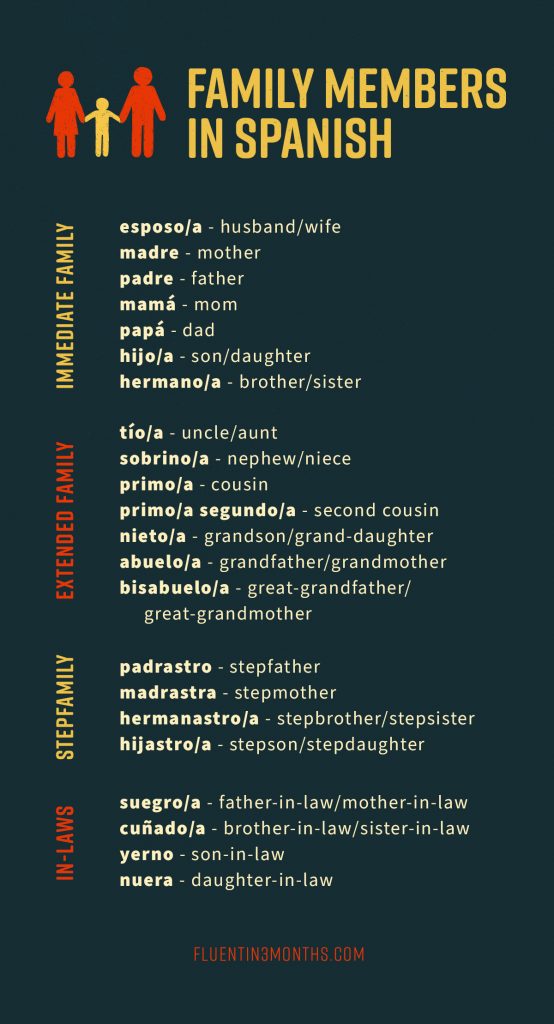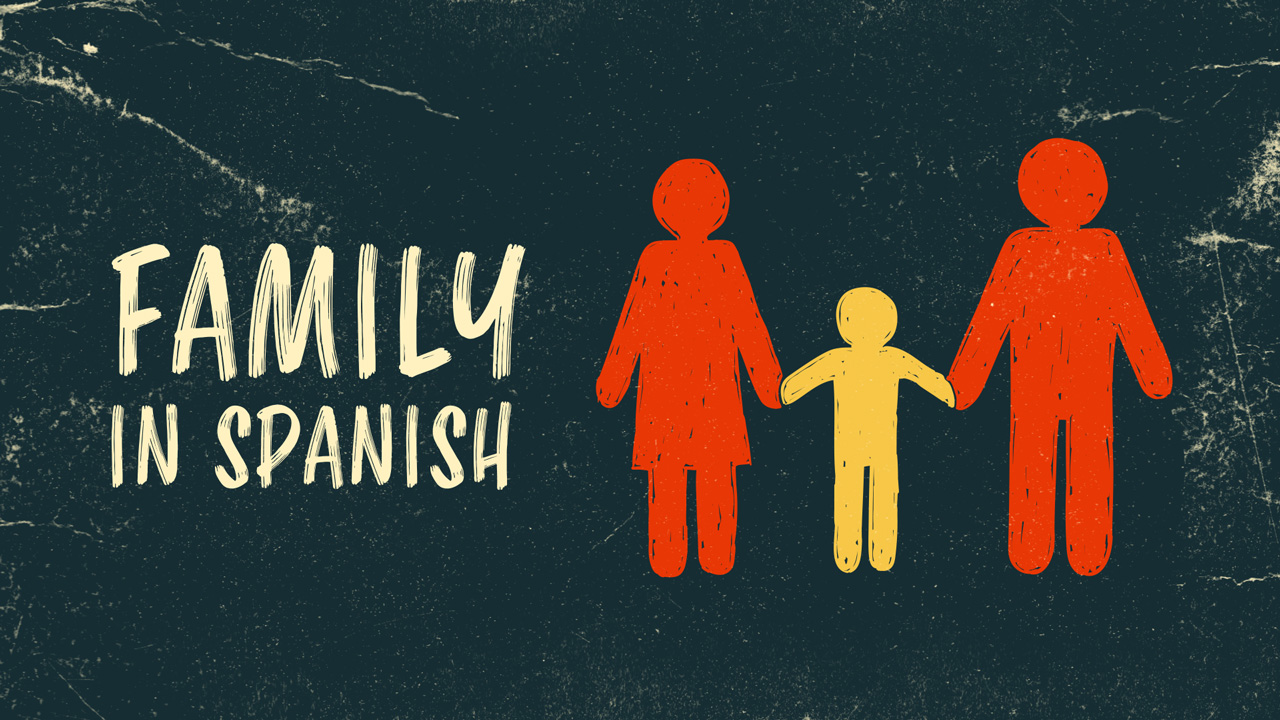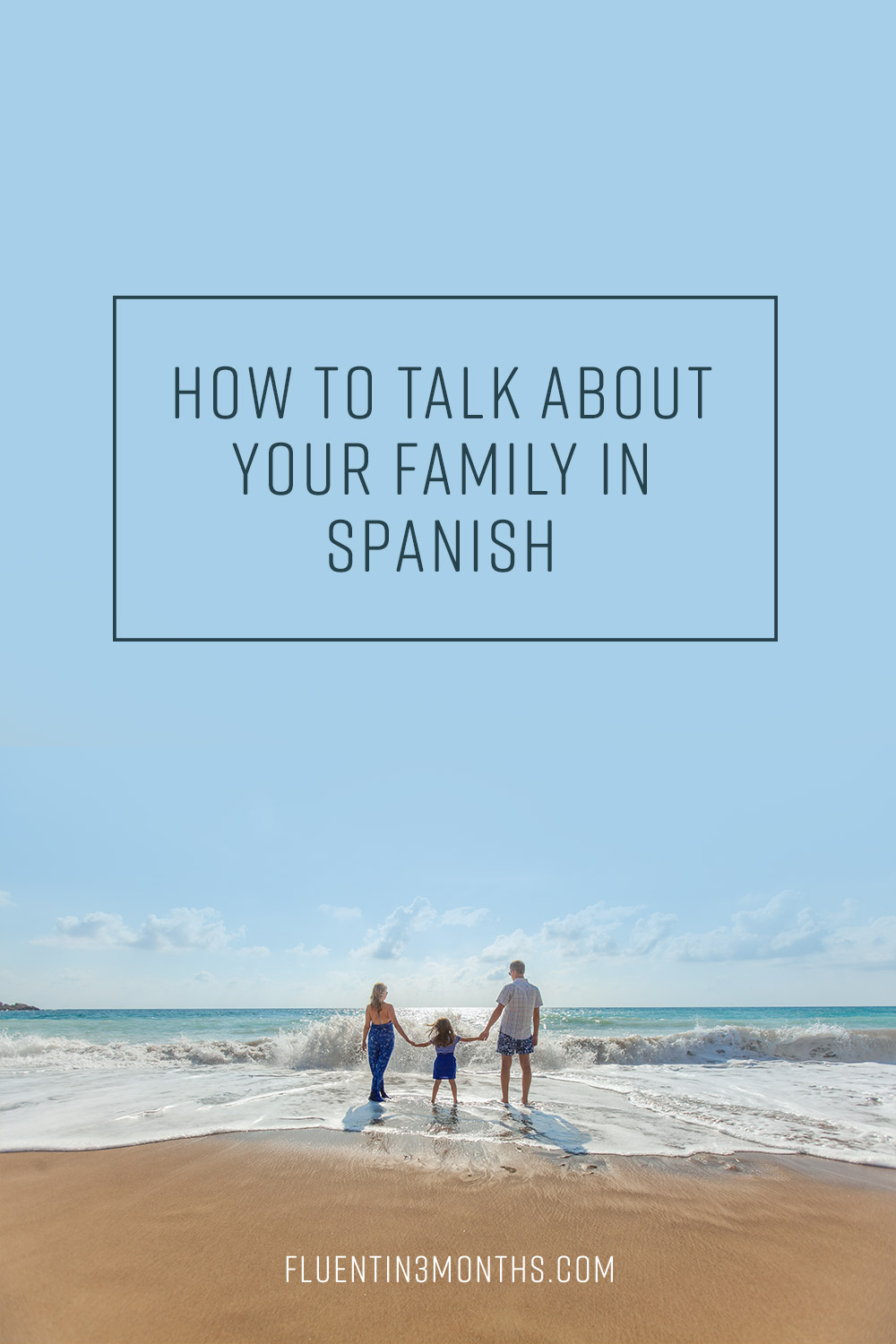How to Say “Family” in Spanish – and How to Talk About Your Family Members
Family in Spanish culture is a really important concept, and the word for family in Spanish is similar to English, familia. Read on for everything you need to know to talk about your family in Spanish.
Here’s what we’ll talk about:
Table of contents
- How to Say “Family” in Spanish: Familia
- How to Say “My Family” in Spanish: Mi Familia
- How to Say “Family Member” in Spanish: Miembro de la Familia
- Spanish Nicknames for Family Members
- How to Say “I Love My Family” in Spanish
- More Spanish Sentences and Phrases About Family
- Now You Can Talk About Family in Spanish!
I grew up torn by my dual nationality, never knowing where I belonged. The number of countries I’ve lived in is greater than the number of years I spent living in my birthplace. For these reasons, I’ve grown up knowing that home isn’t a place. Home is the people you love. And the people I love the most are my family!
You can bet your target language I’ll teach you all you need to know about family vocabulary in Spanish.
Grab a pen and a notepad, and let’s get started!
How to Say “Family” in Spanish: Familia
As I mentioned, in Spanish, “family” is familia.
If you want to go a little more in-depth, you can learn the different types of family categorization in Spanish:
- la familia inmediata – “immediate family”
- la familia extendida – “extended family”
- la familia ensamblada or la familia reconstituida – “stepfamily” or “reconstituted family”
- la familia política – “in-laws”
- la familia adoptiva – “adoptive family” or “foster family”
Let’s pause a second and come back to familia and “family”. Notice how similar the two words look. This is a huge advantage for you!
Familia and “family” are cognates, words from different languages that share the same root and meaning and are pronounced similarly.
Cognates are an amazing way to learn hundreds of words in your target language with almost no effort. You shouldn’t miss out on this opportunity! When it comes to language learning, hacking your way to your goal is allowed. 😉
And I’m not the only one to say so! Benny Lewis encourages you to take advantage of cognates in his guide Why Spanish is Easy.
So yes, remember how similar familia and “family” are.
And while we’re looking at cognates with the “famil-” root, it’s worth learning that “familiar” in Spanish is familiar! The words are spelled exactly the same, only the pronunciation changes.
How to Say “My Family” in Spanish: Mi Familia
You’ve learned how to say “family” in Spanish. Great!
But if you want talk about family in Spanish, chances are you will talk about your family. So how do you say “my family” in Spanish? The answer is mi familia.
In Spanish, the possessive pronoun mi is the equivalent of the English “my”.
Now you might be curious about how to say “your family” in Spanish. Or how to say “family” with any other possessive pronoun.
Here are the answers:
- mi familia – “my family”
- tu familia – “your family” (with tú and vos)
- su familia – “his/her/their/your family” (with usted and ustedes)
- nuestra familia – “our family”
- vuestra familia – “your family” (with vosotros and vosotras)
If you want to learn more about possessive adjectives in Spanish, check out this guide!
How to Say “Family Member” in Spanish: Miembro de la Familia
“Family member” in Spanish is miembro de la familia, which literally translates to “member of the family”.
But we don’t always say “family member” in English. Sometimes, we also use the word “relative”. In Spanish, “relative” is pariente. (In Latin America, you can also hear it as familiar.)
Now that you know how to say “family member”, I can imagine you wondering: what are the family members in Spanish?
How coincidental, I was just about to give you a list!
Actually, to make learning easier, I’ll give you four lists! They’re based on the different categorizations of family you learned earlier.
Familia Inmediata – “Immediate Family”
- la esposa or la mujer – “the wife”
- el esposo or el marido – “the husband”
- la madre – “the mother”
- el padre – “the father”
- la hija – “the daughter”
- el hijo – “the son”
- la hermana – “the sister”
- el hermano – “the brother”
Familia Extendida – “Extended Family”
- la tía – “the aunt”
- el tío – “the uncle”
- la sobrina – “the niece”
- el sobrino – “the nephew”
- el primo (hermano)/la prima (hermana) – “the (first) cousin”
- el primo segundo/la prima segunda – “the second cousin”
- la nieta – “the grand-daughter”
- el nieto – “the grandson”
- la abuela – “the grandmother”
- el abuelo – “the grandfather”
- la bisnieta – “the great-granddaughter”
- el bisnieto – “the great-grandson”
- la bisabuela – “the great-grandmother”
- el bisabuelo – “the great-grandfather”
Familia Reconstituida – “Stepfamily”
- la madrastra – “the stepmother”
- el padrastro – “the stepfather”
- la hermanastra – “the stepsister”
- el hermanastro – “the stepbrother”
- medio hermano or hermano de padre/madre – “half-brother”
- media hermana or hermana de padre/madre – “half-sister”
- la hijastra – “the stepdaughter”
- el hijastro – “the stepson”
Familia Política “In-Laws”
- la suegra – “the mother-in-law”
- el suegro – “the father-in-law”
- la consuegra – “the mother-in-law of one’s son/daughter”
- el consuegro – “the father-in-law of one’s son/daughter”
- la cuñada – “the sister-in-law”
- el cuñado – “the brother-in-law”
- la nuera – “the daughter-in-law”
- el yerno – “the son-in-law”
Here’s a chart you can download to keep these lists at hand!

We shouldn’t forget to mention the “godparent family”:
- la madrina – “the godmother”
- el padrino – “the godfather”
- la ahijada – “the goddaughter”
- el ahijado – “the godson”
Rules of Gender and Number Agreement and the Spanish Family Members Collectives
Nouns in Spanish have a gender: they’re either feminine or masculine.
As you could see in the lists, most of the nouns go in pairs and share the same root (hermano and hermana, suegro and suegra).
It’s the endings that make the difference: most of the feminine nouns end in -a (hermana and suegra) and most of the masculine ones end in -o (hermano and suegro).
Nouns in Spanish also change in function of the number (hermano and hermanos, nieta and nietas). This isn’t too hard to learn, because nouns can be singular or plural in English, too (“brother” and “brothers”, “niece” and “nieces”).
There could be some confusion when it comes to the use of collective versus plural, though. But that’s what we’re about to clarify.
The collective terms are those that group people, like “parents” and “siblings”.
Fun fact: English lacks a collective term for “uncle(s) and aunt(s)”, but Spanish has los tíos.
For family members in Spanish, the collective terms are the plural of the masculine nouns. It’s very simple: “the parents” are los padres and “the siblings” are los hermanos. However, using the plural of masculine nouns only works when the nouns you’re referring to are either all masculine or mixed masculine and feminine.
In other words, use los hermanos if you’re talking about several brothers or a mix of brothers and sisters. If you’re only talking about sisters, use the feminine plural: las hermanas.
If you think about it, the same happens in English: you would say “the siblings” if there is a brother and a sister, but “the sisters” if you’re only talking about female siblings.
Spanish Nicknames for Family Members
When you love someone, you rarely call them by their name or their formal title. In Spanish, there are plenty of ways to nickname your family members!
Let’s start with the parents. Madre y padre are rarely used outside of formal context or adult conversation. With your family and friends, or if you’re addressing a child, you would tend to use:
- la mamá – “the mom”
- el papá – “the dad”
- los papás – “the parents”
The more affectionate terms are mami and papi.
In some Latin American countries, since mami stands for “mom”, grandmothers are often dubbed mamá. It confused me the first time I heard it, but it’s sweet when you get used to it.
Speaking of grandparents… Many families get creative when nicknaming their grandparents, and Spanish gives you plenty of opportunities for that. Here are some of the most common terms for grandparents:
- abu or abue (for both grandparents)
- yaya and yayo
- nana and nono
We could go on and on with this because Spanish is a language with a lot of room for love.
Instead, I’ll show you a trick. There is a simple way to create nicknames in Spanish, and that is by adding the diminutive suffix -ito/a at the end of words.
Here are some examples:
- abuelita and abuelito
- hermanita and hermanito
- primita and primito
This trick doesn’t work with mamá and papá or mami and papi, but it does with most of the Spanish names for family members!
How to Say “I Love My Family” in Spanish
Having a loving family is a beautiful thing, and it’s nice to acknowledge it.
If you ever want to talk about your family in Spanish and say “I love my family”, you have two options:
- Quiero a mi familia.
- Amo a mi familia.
Yes, Spanish has several ways to say “I love…”.
Usually, the verb querer (“to love” or “to want”) is used to express sweet, mild love. On a scale from “friendship” to “passion”, it’s closer to friendship. Amar (“to love”) defines a much stronger love.
There are other phrases that you can use to recognize your love for your family. You could say “family is everything”, for example. In Spanish, “family is everything” is translated to la familia lo es todo. Todo means “everything”.
If you’d rather say “family forever”, in Spanish you should say la familia es para siempre. Or maybe you’re more of a “family first” kind of person? “Family first” is la familia primero in Spanish.
More Spanish Sentences and Phrases About Family
Ready for some more family-related vocabulary? Let’s talk about other family-related phrases you might hear in Spanish.
First, let’s work on learning the Spanish version of “How is your family?” After all, asking about someone’s family is a nice way to show you care about them. One of the ways to ask that in Spanish is by saying ¿Cómo está tu familia?
There are more phrasings to ask how someone is doing in Spanish, and you can learn them from this post on Spanish greetings.
When you think of family, you might think of your family tree. In Spanish, a family tree is un árbol genealógico. This literally translates to “a genealogical tree”. So to say “my family tree”, you would say mi árbol genealógico.
If you’ve ever watched a telenovela, you might be familiar with the dramatized Hispanic family feuds on TV. In Spanish, a “family feud” is una disputa familiar.
But not all families are torn by conflict. In fact, Hispanic families are known to be large and loving. If you want to tell your friend they’ve got a “beautiful family” in Spanish, you would call it una hermosa familia. In a sentence, that would be Tienes una hermosa familia. (“You have a beautiful family.”)
Spanish has a few sayings related to family. One of them goes Cuando seas padre, comerás huevo. It’s the equivalent of “You’ll understand when you’ll be older”, but it literally translates to “You will eat eggs when you’ll be a father.”
Benny Lewis, the founder of Fluent in 3 Months, tells you all about this quote in this post about Spanish sayings. He also mentions other quotes that revolve around family!
Now You Can Talk About Family in Spanish!
You’re ready to include family vocabulary in your Spanish conversations!
Maybe you could tell your italki tutor (our review is here) about it and ask them if you can practice talking about family.
Or maybe you’d like to join the Fluent in 3 Months Challenge family and prove yourself that you can have a 15-minute conversation in your target language in 90 days!
If you’re looking for more vocabulary to learn, you could start by checking out the 101 core Spanish words.
If you’re ready for something a little stronger, try working on conjugation! Reflexive verbs are a good starting point.
In any case, you’re doing great! Learning a new language is a challenge, and you’re on the right path.
I have to go video call my family now. ¡Hasta luego! (“See you soon!”)




Social